by | Mohd Nurul Azammi Mohd Nudri | azammi@might.org.my
Emerging technology always leads to new jobs. Positions such as App Developer, Social Media Manager, Ride-sharing Drivers, Autonomous Cars Engineer, Bot Developer, Big Data Analyst/ Data Scientist, Youtube Content Creator, Drone Operator and Millennial Generational Expert are among jobs that were considered experimental in previous years are now indispensable.
According to the World Economic Forum (WEF), the Digital Age is creating many new jobs position that were unheard of 10 years ago. WEF also suggests that 65 percent of children entering primary school today will ultimately end up making a living off an occupation that does not yet exist. With such an expansion in technology, hundreds of new roles that were unheard of a decade ago are created and will continuously evolve for the next 10 to 20 years.
Although the picture is vague on how these trends will intersect and unfold to create future scenarios, it is imperative that we fully understand these trends to encourage a more proactive role in anticipating future challenges especially by the policy makers, industry leaders, community heads, academia, non-governmental organisations and other stakeholders.
 TREND 1: Aging World
TREND 1: Aging World
An aging nation as defined by the United Nations is a country with 14 percent of its population aged 65 and above. In 2017, several nations were recognised to have highest number of aging populations such as Japan, Germany, Italy, Greece, and Bulgaria—each holding a record of more than 18 percent. Between 2015 and 2030, the number of people in the world aged 60 years and above is estimated to grow by 56 percent. Although Malaysia’s aging population is low, it is projected that by year 2040, 14.5 percent of the population will be senior citizens.
This trend is driven by many factors including;
- Declining birth rates in nearly all regions of the world. Total fertility counts in countries such as Africa, with the highest birth rate in the world, has fallen from 5.1 births per woman in 2000-2005 to 4.7 in 2010-2015. Malaysia is also experiencing slow growth with the annual population rate decreasing from 1.8 percent in 2010 to an estimated 0.8 percent in 2040. On average, the population growth rate in Malaysia is decreasing by 0.05 percent each year.
- Increasing life expectancy has shown an upward trend globally (65 years for male and 69 years for female in 2000- 2005 to 69 years for male and 73 years for female in 2010-2015). Advancements in public health and medical technologies, along with improvements in living conditions have made this possible. In Malaysia, a study highlighted that the median age of Malaysians in 2010 was 26.3 years and is projected to rise to 38.3 years in 2040, an increase of 12 years over the period of 30 years.
Countries need to identify and formulate the right mechanism to be able to tap into this pool of aging communities in the workforce. For example, the Japanese government has decided to raise the official age of retirement to age 65 by 2025 to reduce pressure on a shrinking tax base and rising social welfare bill. Unemployment has dropped to its lowest in two decades in Japan, in part because so many of the country’s elderly are still working. Companies such as Suntory Holdings and Aeon Co Ltd are already leading the way in managing Japan’s aging population. Another Korean start-up company, EverYoung, is hiring only employees that are over 55 years old.
TREND 2:Women Empowerment
Gender inequalities in the labour market continues to be discussed in global agendas especially in pursuing the 2030 Sustainable Development Goals (SDGs). According to International Labour Organization (ILO), the chances for women to participate in the labour market remain almost 27 percent lower than for men worldwide.
Nevertheless, the participation of women in the workforce is on the rise. In some countries, gaps have narrowed and women are shifting away from contributing family work and moving to the services sector. Substantially more than half of the world’s women are employed in the service sector—since 1995, women’s employment has increased from 41.1 percent to 61.5 percent. McKinsey Global Institute forecasted that if women participated in the economy at a level identical to that of men, it would add up to US$ 28 trillion or
26 percent of annual global gross domestic product (GDP) in 2025, assuming a businessas-usual scenario. This impact is roughly equivalent to the size of the combined United States and Chinese economies today.
This increasing trend is also demonstrated by labour participation rate in Malaysia. A Government agency, Talent Corp reported that female labour participation rate (FLPR) climbed to 54.1 percent in 2015 from 46.8 percent in 2010. As much as 7.3 percent increase in FLPR has resulted in an additional 750,000 women entering the workforce. This is estimated to have contributed an additional 0.3 percentage points to GDP growth per annum.
TREND 3: Digital Natives
U.S. author Marc Prensky in 2001 coins the term digital natives to describe a person that grows-up in the digital age. The term digital native doesn’t refer to a particular generation but instead, is a catchall category for children who have grown up using technology like the Internet, computers and mobile devices. Their preference and notion about careers and workplace are different from previous generations—therefore it is crucial for employers to transform with time to attract future talents. For example, unlike previous generations which were structured in rigid hierarchical management with policies and procedures, the millennial and digital natives are inclined towards more flexibility, autonomy, access to real-time learning, a sense of stability, and the ability to pursue projects that are personally meaningful.
In Malaysia, the younger workforce can be divided into two (2) cohorts; First cohort, known as Gen-Y are born during the 1980’s difficult economic circumstances and political upheavals of the past. They learned that the world is uncertain and as a result they actively try to minimise risk and maximise opportunity for themselves—these values are demonstrated a variety ways; through their work, lifestyle and buying habits.
While the second cohort, born in the 1990’s were not so impacted by difficult times and are much more influenced by the opportunities of a promising future, particularly due to the rapid development of digital technology and globalisation. They are more willing to take on potentially risky challenges and less likely to create distinctions between their professional and personal
lives.
TREND 4: Migration and Cultural Diversity
Global migration has increased incredibly in the past few decades due to several factors such as geo-political, social preference, economic opportunities and climate change. The number of immigrants recorded by UNHCR now is three times higher than in 1960. Currently, 3.3 percent of the world’s population is not living in their birth country. Although migration seems advantageous in providing a supply of job talents, it may also cause friction from cultural point of view.
Similar increasing trend can be seen in Malaysia as shown by the statistic from Economic Planning Unit (EPU) since 2000 to 2015 (Figure 1). Between the year 2014 to 2015, 2.6 percent of population in Malaysia are migrants with 88.4 percent internal migrants and 11.6 percent international migrants. Malaysia needs international talent and investments for economic growth and sustainability, which results into an expanded and more diverse multi-racial society.
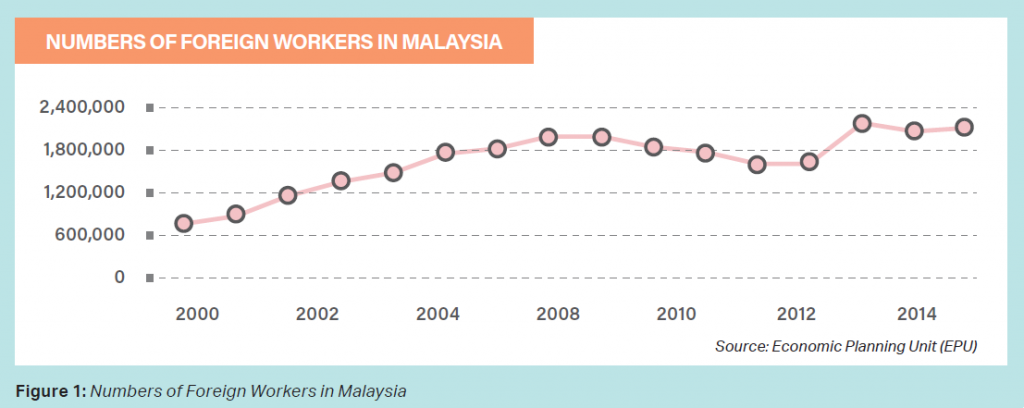
TREND 5: Urbanisation
The share of the world’s population living in cities now stands at 3.7 billion people and this number is expected to double by 2050— with two of every three people will be living in a city. According to the World Bank, this trend of urbanisation will likely continue and by 2030, all urbanisation will
occur in the developing world. This global shift toward a more urban global population has profound implications for a wide range of issues especially job talents.
The UN has defined a mega-city as having a population of at least 10 million people. The number of
mega-cities has grown from 10 in 1990 to 31 in 2016, and another 10 cities are projected to reach megacity status by 2030. The largest city in the world is currently Tokyo, Japan, home to approximately 38,140,000 residents. Malaysia is also facing rapid urbanisation at the rate of 1 per cent every year according to the Department of Statistic.
There are several common factors prompting this global phenomenon according to the Grayline Group. One prominent factor, the advancement of agricultural methods and machinery, is decreasing the number of workers required to sustain agricultural production. Another factor is the nature of modern economies, specifically the increasing concentration of wealth creation and the specialised nature of modern workforces. The steady flow of migrants congregating in a city will escalate and as city life becomes a reality for an ever-greater share of the world’s population, governments, companies, civil society must recognise the growing needs for energy, houses, transport, food, water, sanitation care and education.
TREND 6:Blurring Boundaries of
Traditional Sector Job demarcation that was so previously defined is now converging between industries and sectors. The exponential growth f technologies is exposing a new set of jobs to the possibility of automation and occurs in three (3) major perspectives namely human and machine boundary, producer and consumer boundary and physical and digital boundary (Blurring boundaries, uncharted frontier, Deloitte).
In a future where the world is ruled by automation and artificial intelligence, jobs can be copied by technology and machines can replace humans. Technology has also made it possible for some routine cognitive jobs to be done in other parts of the world where labor costs are lower, for example offshore call centers and backoffice functions. Application of AI such as machine learning where automation or robots are able to perform self-learning through feeding of relevant data, enhances precision of undertaking a particular task. Other types of application are knowledge representation and reasoning and machine to machine (M2M) communication, to name a few.
The blurring of producer and consumer boundary is a consequence of the consumers’ shift from passive to active in production of tangible and intangible products. For intangible products in a sharing economy, the production of valuable data can be shared across the world through social media and other types of online platforms such as blog and YouTube. While tangible products
ranges from simple designs such as cutlery, toys, prosthetic parts, to complex items such as weapons, buildings or cars can be produced using 3D printing machine.
When this scenario occurs, production is going to be decentralised from a giant manufacturing level to a smaller scale, and may create job opportunities that can be performed even from home.
The blurring of physical and digital boundaries occurs when both worlds are getting to look more alike. This is driven by the increasing pace and scope of Internet computing, artificial intelligence, and big data to create seamless consumer experiences. Using smartphones and other digital devices, consumers are able to do everything from shopping to dating. As one example, Alexa personifies the Amazon brand, a cloud-based digital assistant driven by artificial intelligence and natural language capable of voice interaction, music playback, making to-do lists, setting alarms, streaming podcasts, playing audiobooks, and providing weather, traffic, and other real time information. Next, Google and Facebook will further enhance consumer’s experience with augmented and virtual reality technologies such as Google glass and Oculus, respectively.
TREND 7:Hyper-Connectivity
Hyper-connectivity is a world where people, information, and objects around us are connected via global networks. The industry revolution brings technologies that enable communication between person-to-person, person to machine and machine-to-machine (M2M) through computing technologies. By 2030, SAP projected that there will be 50 billion connected devices in the internet of things (IoT). (Figure 2)
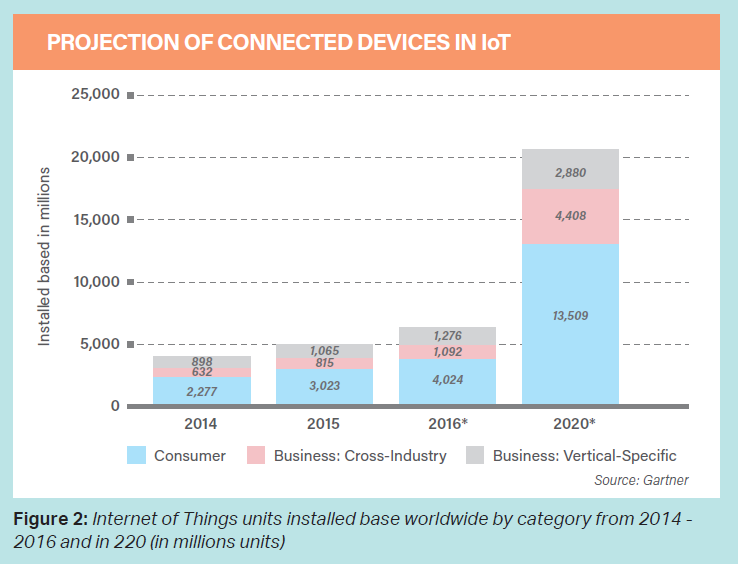 Advancing future connectivity, billions dollar worth of investments on the idea to beam internet service around the world (known as space internet) is already drawn up by renowned companies such as Facebook, SpaceX, Google (Project Loon), Qualcomm and Virgin (OneWeb). Everyone on Earth can access the Internet without building an untenable amount of infrastructure. These initiatives will expand digital inclusiveness of people, especially in providing equal opportunities for rural areas to have the same access to information, people and others now available to people in urban areas.
Advancing future connectivity, billions dollar worth of investments on the idea to beam internet service around the world (known as space internet) is already drawn up by renowned companies such as Facebook, SpaceX, Google (Project Loon), Qualcomm and Virgin (OneWeb). Everyone on Earth can access the Internet without building an untenable amount of infrastructure. These initiatives will expand digital inclusiveness of people, especially in providing equal opportunities for rural areas to have the same access to information, people and others now available to people in urban areas.
Malaysia is one of the developed nations with the highest technology readiness ranking according to world competitiveness index. Moving towards 2025, in preparing for the trend, the National IoT Strategic Roadmap formulated in 2015 has set three (3) major goals namely; to create a conducive IoT industry eco-system, to strengthen technopreneur capabilities in Apps and Service layer, and to turn Malaysia into a regional development hub for IoT. Therefore, several targets are to be achieved such as mobile and device penetration from 147 percent to 280 percent, growing internet users from 65.8 percent to 195 percent, mobile broadband penetration from 13.3 percent in 2015 to 167 percent in 2025 and social network penetration from 45 percent to 135 percent.
Hyper connectivity is shaping the future form of jobs and skills. As an example, more connected objects will mean more data will be produced. Big data is doubling every 18 months and the amount of data are growing 50 times from 2010 to 2020. In view of this, analysis work needed to make sense of huge amount of data as well as to provide new-never- encountered insights will become a job that is sought after in the future. Hyper-connectivity makes distance, time and space immaterial. People don’t have to be in the same room, or even in the same country for them to have face-to-face contact and this could certainly produce a new form of workplace. The use of digital collaborative platforms will provide significant savings in time, cost and enable flexibility of a company to tap on talent globally.
TREND 8: Globalisation & Decentralisation
Globalisation will continue to stay driven by factors such as improved communication, improved transportation and logistics, free trade agreements, global banking and the growth of Multinational Corporation (MNCs). Even more pronounced impact of the trend can be noted with the advancement of technologies such as social computing, digital platforms, internet of things and Blockchain.
While globalisation continues, the economic trend is moving from centralisation to decentralisation. Decentralisation is the process of redistributing or dispersing functions, powers, people or things away from a central location or authority. The traditional model, which runs on centralised activities, will no longer be competitive and sustainable as the world economic system moves towards collaboration between individuals and the sharing of resources. A popular example of this trend is Uber, the world’s largest taxi company, who owns no vehicles. Facebook, the world’s most popular media owner, creates no content. Alibaba, the most valuable retailer, has no inventory. And Airbnb, the world’s largest accommodation provider, owns no real estate.
More examples of decentralisation are happening in the financial system with emergence of a
technology platform called Blockchain. It is a shared database of transactions among parties designed to increase security, transparency, and efficiency (Goldman Sachs). The invention and use of Bitcoin as a cryptocurrency eliminates the need for a centralised server or a trusted authority. In energy sector, advancement of solar and wind technology, high capacity battery, smart and micro-grid couple with Blockchain technology will cause a shift in power producing from a large corporation to the level of an individual house as demonstrated by a community in Brooklyn, New
York. The community demonstrated a peer-to-peer energy sales network based on blockchain technology whereby homes with rooftop solar power can sell to their neighbors on the same street who do not have solar power installed. Last but not the least, Youtube, Instagram and other tools on the Internet are empowering the ordinary aspiring citizen to create content, make his own channel on Youtube and become a star— basically, anyone with an internet connection can become the world’s most watched YouTuber without the help of big media houses if they produce quality content.
TREND 9: Rise of Machines
Automation has been around for decades and existed with the purpose to save manual labour, increase productivity and create high value jobs. In the past, automation is highly structured in predictable environments and limited to collection and processing of data. The new age of automation where advancement of technology especially in artificial intelligence, internet of things, machine learning and big data among others have further enhanced the capabilities of machine to perform beyond non-cognitive and routine tasks. Machines which are known to
perform assembly of parts in production line of a factory are slowly replacing jobs that are currently performed by humans— not limited to factory workers but including professionals such as doctors, lawyers, accountants, truck drivers, police, builders, cooks, journalists, composers and surgeons.
Recently, Russian President Vladimir Putin stated that whoever reaches a breakthrough in developing artificial intelligence will dominate the world (ABC News). This is reflected by the increasing trends of financing start-ups reaching high in 2016 growing from USD589 million in 2012 to USD 5 trillion which is almost eight (8) folds in just five (5) years. (Figure 3)
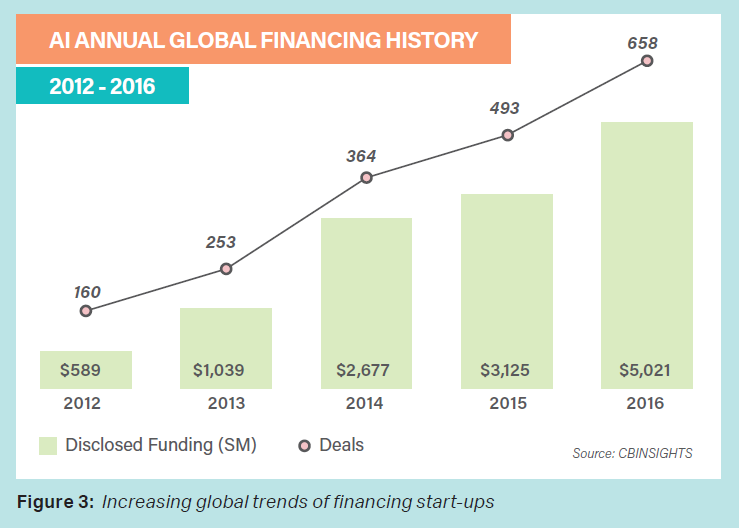
According to IFR World Robotics, there has been a steady increase of industrial robots from 2010 and it is projected to grow with an average of 15 percent from 2016 to 2018 (Figure 4). The IFR estimates that there are currently between 1.5 and 1.75 million industrial robots in operation, a number that could increase to 4 to 6 million by 2025 (Boston Consulting Group, 2015).
China is leading in terms of installing more robots compared to other countries in the world followed by South Korea, North America, Japan and Germany. Companies are considering the smart machines with such capabilities because it they can deliver higher output with lower cost and comes without welfare entitlements. However, there are five (5) key factors that will influence the pace and extent of these smart machines, including technical feasibilities, cost of developing and deploying solutions, supply, cost and benefits of human labour as an alternative to automation, productivity rate and regulatory and social acceptance.
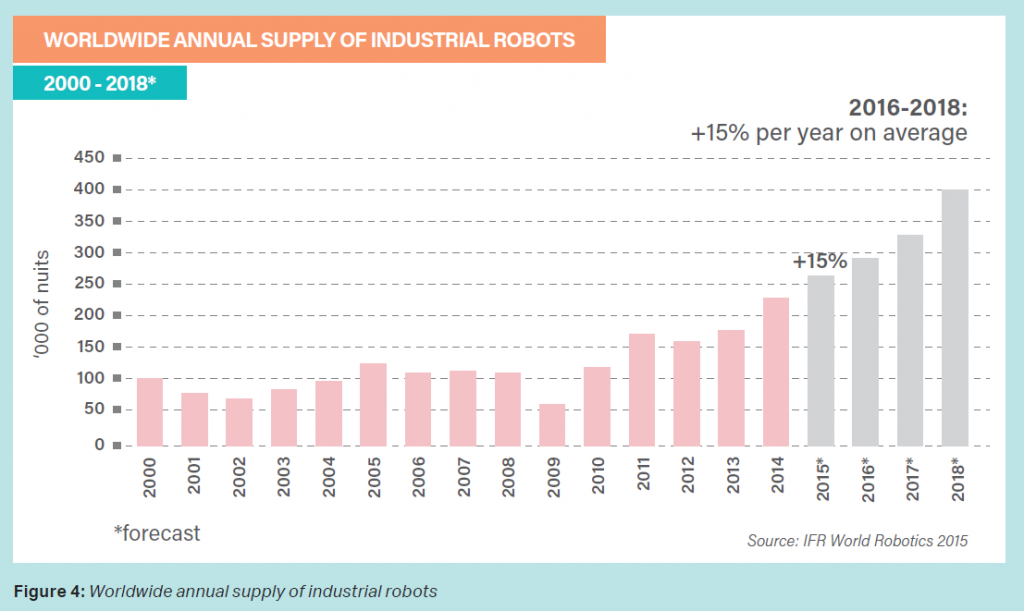
TREND 10: Green & Sustainability
The effects of climate change such as global warming, rising of sea level, drought, haze, and flood, calls for a global response to ensure the Earth is habitable for many years to come. The race for economic growth has continuously put the pressure on existing resources and without a sustainable mind-set, the damage costs of climate change will be increasing over time, thus compromising the need of future generations. In addressing this, initiatives such as Sustainable Development Goals 2030 are a universal call to action to end poverty, protect the planet and ensure that everyone can enjoy peace and prosperity.
Respective countries are formulating their plans to combat the effects of climate change particularly in the mobility sector. For example, Emmanuel Macron’s government has announced that France will end sales of petrol and diesel vehicles by 2040 as part of an ambitious plan to meet its targets under the Paris climate accord (Guardian). Following suit, The U.K. would ban sales of new gasoline and diesel cars starting in 2040 as part of a bid to clean up the country’s air and by 2050, all cars on the road will need to have zero emissions. The Norway’s government’s transportation plan outlines a clear target—All new passenger cars and vans sold in 2025 should be zero-emission vehicles. Moreover, India made a bold statement that every vehicle sold in the country should be powered by electricity by 2030. At least 10 other countries have electric car sales targets in place, according to the International Energy Agency (IEA)—Austria, China, Denmark, Germany, Ireland, Japan, the Netherlands, Portugal, Korea and Spain have set official targets for electric car sales.
Many carmakers are echoing the same sentiments by expanding their product lines into making electric cars. Tesla is leading in this market share and taking a cue from the electric car manufacturing leaders. President and Ceo of Volvo stated that starting 2019 onwards, all vehicles manufactured by Volvo would either be hybrid or electric. Toyota Motor Corp and Mazda Motor Corp recently announced they would join forces to develop electric vehicle technologies. Other car makers including BMW, Daimler, Nissan-Renault, Hyundai-Kia, Ford, General Motors, Subaru, and Volkswagen are expanding their product portfolios to include electric cars.
Smart is the new green where the trend of green products will be replaced by smart products and services. This is driven by technologies such as internet of things (IoT), machine learning and advanced materials. Application of the technologies into the smart cities concept to include smart energy, smart mobility and smart building will also occur as well. As an example, China is building vertical forests that will contain more than 1,100 trees and 2,500 plants that will produce 60kg of oxygen a day and absorb 25 tons of CO2 every year.
CHALLENGE 1: Declining of Working Population
ILO projected rate of labour participation is expected to stabilise at 62.8 percent of the global working-age population and subsequently exhibit a moderate downward trend to 62.5 percent until the year 2020. However, it is suggested that the trend may continue to decline until year 2050. (Figure 5)
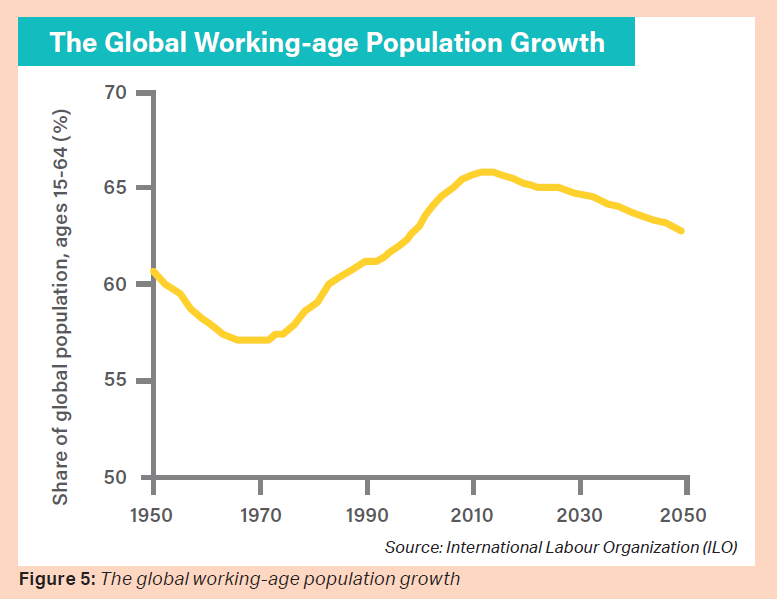
Will Malaysia maintain the growth or decline in the next 10 or 20 years owing to aging population, low birth rate and economy uncertainty?
CHALLENGE 2: Multi-Generational Culture
For the first time in history, by 2020 there will be at least four generations—Baby Boomers,
Generation X, Generation Y (or Millennials) and Generation Z—that will be working together in a workplace. Here, employers will face the challenge of managing a workforce while having to consider the unique strengths and differences of each generation.
Different ways of thinking, communication, expectation, values, characteristics and preferences may create friction in the multigenerational workforce. This scenario may materialise due to perception of negative stereotypes on a particular generation. As an example, millennials may be referred as lazy, technology obsessed, overeager to challenge norms while the older generation is posed as rigid, difficult to train, hierarchical and procedure oriented.
How can employers offer the ideal workplace to attract the best talents from different generations? What type of mechanism is required to motivate a multi-generational workforce to enable a business to meet its goals?
CHALLENGE 3: Large Number of Jobs are at Risk
The rise of automation and robots has brought along transformation to jobs traditionally undertaken by human for decades. In view of enhanced capabilities to perform tasks beyond non-cognitive and routine activities, alarming signals has been raised globally especially to policy makers, industry players and academicians. The advancement of technology is currently feasible to automate job activities that involve predictable
physical work, data procession and data collection. (Figure 6)
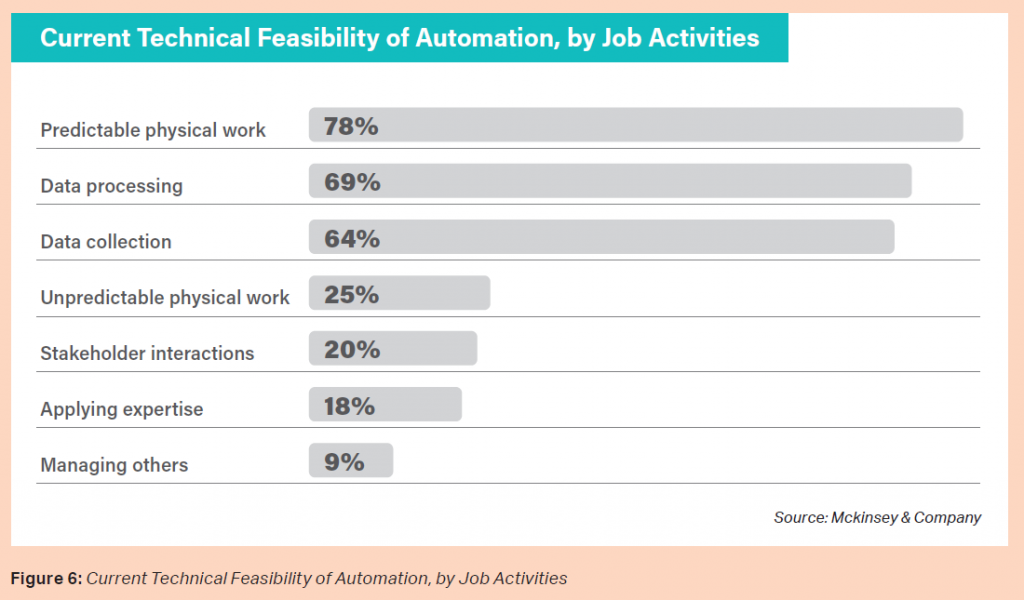
The World Bank estimates that 57 percent of jobs in the OECD could be automated over the next two decades (World Development Report, 2016). The risks are varied from country to country, for example, China (77 percent), India (67 percent), UK (35 percent) and USA (47 percent). The jobs at risk include; high risk jobs such as waiter/waitress, receptionist, insurance sales agents, cooks/ bakers, secretary and low risk jobs such as software developer, scientist, nutritionist, nurses, sport coach.
The impact of automation and robots has already begun. A company in Dongguan City, China known as Changying Precision Tech has replaced 90 percent (650 people) of its employee with 60 robots and in Europe, it is more cost effective to deploy robots compared to humans. For example, a car worker in Germany costs more than €40 (£34) an hour, while a robot costs between only €5 and €8 per hour. This time around, automation and robots are making a wider leap not only comprising of low-income jobs but for the middle-income jobs too. Consequentially, the fields of professionals with more specialised jobs will be impacted as well. In the long run, it will bring a significant impact to the growth of the economy as a large number of consumers are from the middleincome group. Moving up to higher skills and knowledge in the current field to be promoted in the workplace seems to be inadequate for the future. The future of work requires workers to move up vertically and horizontally in terms of developing multiple skills and knowledge of other fields.
This scenario is inevitable in Malaysia where the main economy is driven by services and manufacturing activities. Is the country ready to weather such challenges?










